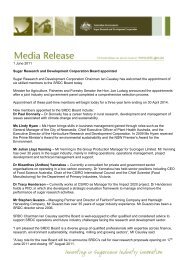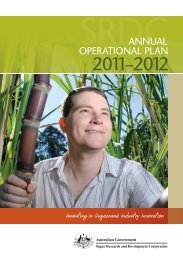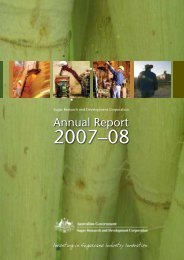Section 2 - Sugar Research and Development Corporation
Section 2 - Sugar Research and Development Corporation
Section 2 - Sugar Research and Development Corporation
Create successful ePaper yourself
Turn your PDF publications into a flip-book with our unique Google optimized e-Paper software.
52<br />
REGIONAL FUTURES<br />
Regional futures<br />
Key<br />
Performance<br />
Indicator<br />
Enhanced resource utilisation<br />
in the farming <strong>and</strong> harvesting<br />
sectors<br />
Measure Implementation of improved<br />
farming <strong>and</strong> harvesting systems<br />
that increase revenue <strong>and</strong> reduce<br />
input costs, <strong>and</strong> concurrently<br />
are environmentally <strong>and</strong> socially<br />
sustainable.<br />
Accelerating the adoption of best practice<br />
nutrient management in the Australian <strong>Sugar</strong><br />
Industry<br />
The SIX EASY STEPS nutrient management package<br />
facilitates the adoption of appropriate on-farm<br />
nutrient management practices by encouraging<br />
growers to make informed decisions about their<br />
nutrient inputs.<br />
This project enabled further development<br />
<strong>and</strong> validation of the SIX EASY STEPS package<br />
resulting in a number of important outputs <strong>and</strong><br />
outcomes consistent with the philosophy of<br />
sustainable sugarcane production. It also provided<br />
an opportunity to promote <strong>and</strong> accelerate the<br />
adoption of best-practice nutrient management<br />
across the Australian sugarcane industry.<br />
The strategic importance of the SIX EASY<br />
STEPS package increased substantially with the<br />
introduction of the Queensl<strong>and</strong> Government’s<br />
reef regulations <strong>and</strong> the requirements of the<br />
Reef Rescue Program. Importantly, further<br />
enhancements to SIX EASY STEPS will continue<br />
through initiatives led by BSES Limited in<br />
association with others (BSS268).<br />
<strong>Sugar</strong>cane smut extension<br />
<strong>Sugar</strong>cane smut occurs in every commercial<br />
sugarcane-producing country around the world<br />
except Papua New Guinea <strong>and</strong> Fiji. Its most<br />
signifi cant facet is its systemic mode of infection<br />
<strong>and</strong> the effect on crop growth, commercial yields<br />
<strong>and</strong> profi tability.<br />
This project used the opportunity afforded by<br />
the large number of infested crops in Australia<br />
to quantify the effect of the disease on commercial<br />
crop yields <strong>and</strong> optimize industry transition to<br />
resistant commercial varieties.<br />
SRDC Annual Report 2010–2011<br />
The results of the project showed growers<br />
how to choose varieties to minimise crop losses<br />
<strong>and</strong> terminate appropriate crops to maximize<br />
profi tability. It assisted the breeding <strong>and</strong> selection<br />
program by providing knowledge of the level of<br />
resistance needed to minimise productivity loss<br />
<strong>and</strong> maximise the use of high yielding germplasm,<br />
<strong>and</strong> improved the accuracy of predicting the impact<br />
of smut across the industry.<br />
Over 90 seminars were presented by project<br />
staff on the fi ndings of this epidemiology research<br />
during the 3.5-year project period <strong>and</strong> the project<br />
results were widely published (BSS302).<br />
<strong>Sugar</strong>cane Biosecurity Integrated Plan<br />
This project developed updated old Incursion<br />
Management Plans for key exotic pests <strong>and</strong> diseases<br />
to enhance sugarcane biosecurity measurements<br />
for the Australian sugarcane industry.<br />
The Biosecurity Plan was revised <strong>and</strong> updated to<br />
align with PLANTPLAN in light of the lessons learnt<br />
from the smut emergency response experience,<br />
while a Brief Action Plan <strong>and</strong> a Borer Response Plan<br />
were compiled to serve as a quick source<br />
of information in case of a pest incursion.<br />
Several workshops <strong>and</strong> local grower meetings<br />
were held to emphasise the biosecurity message<br />
<strong>and</strong> deliver the fi ndings. Biosecurity is now a<br />
regular feature in the BSES Bulletin. All Incursion<br />
Management Plans are now available at www.bses.<br />
org.au (BSS303).<br />
Establishing the second crop cycle into<br />
permanent beds<br />
The project assisted growers to develop practical<br />
solutions to establish break crops <strong>and</strong> the second<br />
cane-cropping cycle onto permanent beds with<br />
appropriate bed maintenance <strong>and</strong> retention of<br />
undisturbed crop residues, therefore maintaining<br />
soil structure <strong>and</strong> biology.<br />
Four pieces of farming equipment were developed:<br />
a bed renovator, zonal ripper, wave disc cultivator<br />
<strong>and</strong> zonal rotary hoe. Grower groups were formed<br />
<strong>and</strong> 36 extension activities were held along with<br />
published material <strong>and</strong> Reef Rescue promotion<br />
to encourage grower participation.






